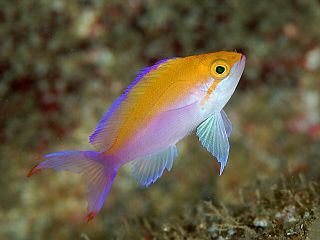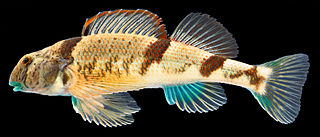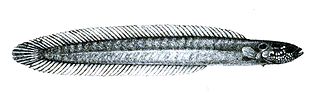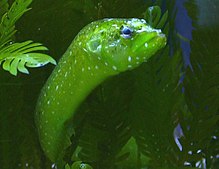
Combtooth blennies are blenniiformids; percomorph marine fish of the family Blenniidae, part of the order Blenniiformes. They are the largest family of blennies with around 401 known species in 58 genera. Combtooth blennies are found in tropical and subtropical waters in the Atlantic, Pacific and Indian Oceans; some species are also found in brackish and even freshwater environments.

The giant grouper, also known as the Queensland grouper, brindle grouper or mottled-brown sea bass, is a species of marine ray-finned fish, a grouper from the subfamily Epinephelinae which is part of the family Serranidae, which also includes the anthias and sea basses. It has a wide Indo-Pacific distribution and is one of the largest extant species of bony fish.

The dottybacks are a family, Pseudochromidae, of fishes which were formerly classified in the order Perciformes, but this has been revised and the family is regarded as of uncertain affinities, or incertae sedis within the Ovalentaria, a clade within the Percomorpha. Around 152 species belong to this family.

Epinephelus albomarginatus, the white-edged grouper, white-edged rockcod or captain fine, is a species of marine ray-finned fish, a grouper from the subfamily Epinephelinae which is part of the family Serranidae, which also includes the anthias and sea basses. It is found in the southwestern Indian Ocean and it is associated with coral reefs. It is a target species for commercial and recreational fisheries.

The orange-spotted grouper, also known as the brown-spotted rockcod, estuary cod, estuary rockcod, goldspotted rockcod, greasy cod, North-west groper, orange spotted cod or blue-and-yellow grouper, is a species of marine ray-finned fish, a grouper from the subfamily Epinephelinae which is part of the family Serranidae, which also includes the anthias and sea basses. It has an Indo-Pacific distribution and is found in marine and brackish waters.

The speckled hind, also known as the calico grouper, kitty mitchell or strawberry grouper, is a species of marine ray-finned fish, a grouper from the subfamily Epinephelinae which is part of the family Serranidae, which also includes the anthias and sea basses. It is found in Bermuda and off eastern coast of North America. Its natural habitats are open seas, shallow seas, subtidal aquatic beds, and coral reefs. It is threatened by habitat loss.

The snowy grouper is a species of marine ray-finned fish, a grouper from the subfamily Epinephelinae which is part of the family Serranidae, which also includes the anthias and sea basses. It is found in the western Atlantic Ocean.

The Hawaiian grouper, also known as the Hawaiian black grouper, Seale's grouper or Hapuʻupuʻu, is a species of marine ray-finned fish, a grouper from the subfamily Epinephelinae which is part of the family Serranidae, which also includes the anthias and sea basses. It is endemic to Hawaii.

Cephalopholis miniata, also known as the coral grouper, coral hind, coral rock cod, coral cod, coral trout, round-tailed trout or vermillion seabass is a species of marine ray-finned fish, a grouper from the subfamily Epinephelinae which is in the family Serranidae which also includes the anthias and sea basses. It is associated with coral reefs and occurs in the Indo-Pacific.

Pseudanthias bicolor, the bicolor anthias or yellowback basslet is a species of marine ray-finned fish from the subfamily Anthiinae of the family Serranidae, the groupers and sea basses. It is from the Indo-Pacific Ocean. It occasionally makes its way into the aquarium trade. It grows to a size of 13 cm in length.

Cephalopholis panamensis, the Pacific graysby or Panama graysby, is a species of marine ray-finned fish, a grouper from the subfamily Epinephelinae which is in the family Serranidae which also includes the anthias and sea basses. It is found in the Eastern Pacific Ocean.

The blenny darter is a species of freshwater ray-finned fish, a darter from the subfamily Etheostomatinae, part of the family Percidae, which also contains the perches, ruffes and pikeperches. It is a poorly known species which occurs in Alabama and Tennessee where it inhabits swift riffles.
'Pseudanthias ignitus, the flame anthias or flame basslet is a species of marine ray-finned fish, an anthias from the subfamily Anthiinae part of the family Serranidae, the groupers and sea basses. It is found in the Indo-Pacific region.

Congrogadinae is a subfamily of ray-finned fishes, one of four subfamilies that make up the family Pseudochromidae, these elongated fish are commonly called eel-blennies.

The ocellate eel blenny is a species of ray-finned fish from the subfamily Congrogadidae, which is in the family Pseudochromidae. It is the only species in the monospecific genus Blennodesmus. It is found along the northern coasts of Australia, from Western Australia, along the coast of the Northern Territory to Queensland. The ocellate eel blenny is found among coral rubble and occurs in intertidal pools up to a depth of 3 metres (9.8 ft) where it feeds mostly on crustaceans. Like other species of Congrogadid the ocellate eel blenny has eggs covered in hooks, cross shaped hooks in this species. This species has an extremely elongated body, its gill membranes are joineded to the isthmus ventrally. It has one, short lateral line which runs from its shoulder to underneath the front part of the dorsal fin. The body is dark brown in colour with mottled with paler markings and it has a black eyespot, smaller than its eye, located above the opercle. It grows to a maximum length of 8.9 centimetres (3.5 in) standard length.
Halidesmus is a genus of ray-finned fishes, the type genus of the subfamily Congrogadinae, the eel blennies, part of the dottyback family, Pseudochromidae. They are found in the western Indian Ocean as far east as India, with one species extending marginally into the south-east Atlantic Ocean.
Halimuraena is a genus of ray-finned fishes, classified under the subfamily Congrogadinae, the eel blennies, part of the dottyback family, Pseudochromidae. They are found in the western Indian Ocean as far east as the Mascarene Islands, and north to Kenya, although the centre of the genus's distribution appears to be around Madagascar and the Mozambique Channel.

Pseudochrominae is a subfamily of ray-finned fishes, one of four subfamilies that make up the family Pseudochromidae, the species within the subfamily are commonly called dottybacks. They are small reef-associated marine fish which have an Indo-Pacific distribution.
Lumpenopsis is a genus of marine ray-finned fishes belonging to the family Stichaeidae, the pricklebacks or shannies. These fishes are found in the North Pacific Ocean.















